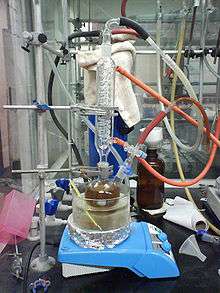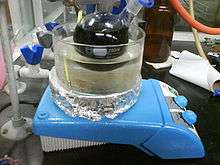Ketyl


A ketyl group in organic chemistry is an anion radical that contains a group =C−O• in which an oxygen radical is bonded directly to carbon, negatively charged. This molecular entity is very unstable and appears in chemical reactions as a reactive intermediate.
Another mesomeric structure has the radical position on carbon and the negative charge on oxygen.[1]
Ketyls can be formed as radical anions by one-electron reduction of carbonyls with alkali metals. Ketyls are also involved in the pinacol coupling reaction and the McMurry reaction.
Reaction with water
Ketyls are used as indicators or drying agents since they are intensely colored but react with water to give colorless products.
The ketyl radicals derived from the reaction of sodium and benzophenone is a common laboratory desiccant. Sodium reduces benzophenone to the soluble ketyl radical, which reacts quickly with the water and oxygen dissolved in the solvent. The deep purple coloration qualitatively indicates dry, oxygen-free conditions. The method, while popular in many laboratories, is inferior in terms of safety and drying effectiveness relative to molecular sieves.[2]
References
- ↑ IUPAC, Compendium of Chemical Terminology, 2nd ed. (the "Gold Book") (1997). Online corrected version: (2006–) "ketyls".
- ↑ Williams, D. B. G., Lawton, M., "Drying of Organic Solvents: Quantitative Evaluation of the Efficiency of Several Desiccants", The Journal of Organic Chemistry 2010, vol. 75, 8351. doi: 10.1021/jo101589h
